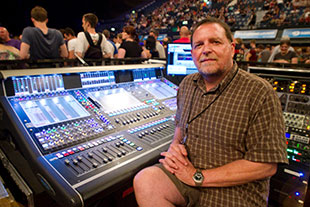With a 20-year relationship with The Smashing Pumpkins and a ten-year history with DiGiCo mixing consoles, FOH engineer Jon Lemon has opted to take the current DiGiCo flagship, the SD7, on the US alternative rock band’s current world tour.
 ‘The D5 Live came out in 2002 – I had one of the prototypes,’ Lemon elaborates. ‘I’ve always used DiGiCo consoles. For me, they are the best sounding of the digital desks and the SD range is very reliable.’
‘The D5 Live came out in 2002 – I had one of the prototypes,’ Lemon elaborates. ‘I’ve always used DiGiCo consoles. For me, they are the best sounding of the digital desks and the SD range is very reliable.’
Promoting the new Oceania album, the tour has taken in a large number of festivals, starting in the US during spring, travelling through Europe and finishing in the Far East with Summer Sonic in Japan and Good Vibes in Kuala Lumpur. The schedule has challenged both crew and kit, and a console that delivers almost everything Lemon needs without the need for much additional outboard, has been particularly welcome.
‘I’ve used just about every one of DiGiCo’s SD consoles now,’ he says. ‘When the SD8 came out, I used that because it’s a smaller, lighter package and we were flying around a lot and we didn’t necessarily want to fly an SD7. Then, when the SD10 came out, I used that for a while. But the SD7 is my personal favourite.’
And being able to integrate Waves software within the SD Range came as something of a revelation: ‘When it first came out, DiGiCo sent an SD10 to my house in Chicago with a brand new Waves Soundgrid so I could get to know it,’ he recalls. ‘I had started working with a band called The Fray and I had some multitracks of their songs. It was pretty interesting being able to set up and mix, just with the console at home and a set of monitors. So I decided not to use any outboard at all and simply use the onboard DiGiCo compressors, gates and dynamic EQ in conjunction with Waves plug-ins.
‘At that point, a light went on in my head. The way gigs and tours work now, we do a lot more fly dates, so I knew I needed to jump onboard with this and get away from the analogue outboard racks that I’d always taken with me. This can save production a lot of money in freight costs.’
The system worked well with The Fray, so when The Smashing Pumkins’ tour came up, Lemon knew he could make it work here too: ‘The Oceania album is different from anything we’ve done before,’ he says. ‘There are quite a lot of sequences on it, with things like analogue synths in the backing tracks; we had around ten backing tracks on Pro Tools, and they wanted to play the whole album.
‘For safety’s sake, I decided I was going to go with the SD7 – that way I would have built in redundancy. I had to build many snapshots to make the album work with the video, so I needed to know I had backup. However, the big updates from both DiGiCo and the Waves V9 plug-ins means that everything is very stable anyway. I use 56 channels, or rather 55 channels, and keep one spare, which keeps us to one 192kHz SD Rack, with [monitor engineer] John Sherman having his own 192 rack for his SD10. I use a lot of the SD7’s internal effects, but there is one bit of outboard I still can’t get away from: which is a Manley Voxbox but I do use that in conjunction with a Waves Renaissance compressor mainly for fast compression.
Madi splits
‘We archive every show and record it straight from the SD7 via the Madi split into our Pro Tools rig. The recording is used for the live album and for virtual sound check. We’ve been on the road for so long now that I don’t really need it for virtual sound check anymore, but when we were starting up of course I used it all the time.’
Now, Lemon uses it more for archiving. ‘Having said that, there’s a 5.1 DVD coming out some time around September that we recorded at Jay-Z’s arena in Brooklyn,’ he adds
Working in the digital domain has additional benefits for touring live: ‘If we’re going to a festival, we let them know upfront we’re not going to give them analogue splits and that it will be a 48kHz or 96kHz Madi split. It works out better for everyone that way, because they have a basic mix from the FOH console to start with and the gains are all correct, so there’s no load on any of the microphones. That’s one of the real benefits of digital and having so much Madi I/O.
‘I find that digital audio simplifies things in a big way, and the benefit of having all the onboard plug-ins is huge – when you need stuff, it’s just there and you can transfer from mixing a show for the website, for radio, for TV, or a festival by just taking the settings from the plug-ins and having them on your DAW. That back and forth between console and Pro Tools really has made life pretty easy over the last year.’
The mixing console, along with the rest of the PA system used on the tour, was supplied by audio rental company Eighth Day Sound.
More: www.digico.org














